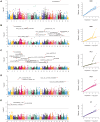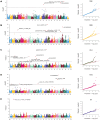Identification of novel marker-trait associations for agronomic traits in bread wheat under WANA environments through GWAS
- PMID: 40779575
- PMCID: PMC12334036
- DOI: 10.1371/journal.pone.0329681
Identification of novel marker-trait associations for agronomic traits in bread wheat under WANA environments through GWAS
Abstract
Bread wheat (Triticum aestivum L.) is a primary staple crop globally and holds particular significance in the West Asia and North Africa region, where it plays a central role in food security and dietary intake. However, rising temperatures, decreased precipitation, and other climate-related stresses increasingly threaten local production. Understanding the genetic basis of agronomic traits is essential for developing high-yielding wheat varieties under harsh conditions. In this study, 191 spring bread wheat genotypes developed by ICARDA for drought and heat tolerance were evaluated across seven environments in Morocco, Sudan, Egypt, and Lebanon for five key agronomic traits. A genome-wide association study using 12,954 SNPs identified 37 significant marker-trait associations (MTAs). The highest number of MTAs was detected for plant height (19), followed by days to maturity (14), thousand kernel weight (5) and three each for days to heading and grain yield. Among these, five MTAs were associated with multiple traits, particularly days to heading, days to maturity and plant height. These included tplb0057m23_716 (5A), AX-94506854 (1B), RAC875_c17628_867 (2A), and wsnp_Ra_rep_c69692_67234463 (3A), validated by both BLINK and FarmCPU models. Candidate genes associated to key traits were identified, such as TraesCS5A02G261900 (tplb0057m23_716), regulating flowering time, pollen maturation and plant height, and TraesCS2D02G583000 (tplb0049b24_1152), associated to grain yield through its role in grain peroxidase activity. Other notable genes include TraesCS5B02G022300 (AX-94476767), encoding N-carbamoyl putrescine amidohydrolase (TaNPLP1-1), involved in abiotic stress tolerance, and TraesCS7D02G102000 (wsnp_Ex_c2054_3852564), associated with cuticular wax biosynthesis for drought and heat protection. Further validation of these SNPs, using inbred lines tested across diverse environments, is required. Once validated, these SNP-derived KASP markers will support breeding for heat- and drought-tolerant lines with desirable agronomic traits.
Copyright: © 2025 Henkrar et al. This is an open access article distributed under the terms of the Creative Commons Attribution License, which permits unrestricted use, distribution, and reproduction in any medium, provided the original author and source are credited.
Conflict of interest statement
The authors have declared that no competing interests exist.
Figures








Similar articles
-
Identification of quantitative trait loci and candidate genes underlying kernel traits of wheat (Triticum aestivum L.) in response to drought stress.Theor Appl Genet. 2025 Aug 19;138(9):216. doi: 10.1007/s00122-025-05001-y. Theor Appl Genet. 2025. PMID: 40828177
-
Deciphering the genetic basis of grain iron and zinc content in wheat under heat and drought stress using GWAS.PLoS One. 2025 Aug 14;20(8):e0329578. doi: 10.1371/journal.pone.0329578. eCollection 2025. PLoS One. 2025. PMID: 40811572
-
Unraveling the genetic basis of heat tolerance and yield in bread wheat: QTN discovery and Its KASP-assisted validation.BMC Plant Biol. 2025 Mar 1;25(1):268. doi: 10.1186/s12870-025-06285-4. BMC Plant Biol. 2025. PMID: 40021958 Free PMC article.
-
Nucleic acid-based strategies to mitigate stripe rust disease of wheat for achieving global food security - A review.Int J Biol Macromol. 2025 Aug;319(Pt 4):145353. doi: 10.1016/j.ijbiomac.2025.145353. Epub 2025 Jun 17. Int J Biol Macromol. 2025. PMID: 40553877 Review.
-
A meta-analysis of genome-wide association studies to identify candidate genes associated with feed efficiency traits in pigs.J Anim Sci. 2025 Jan 4;103:skaf010. doi: 10.1093/jas/skaf010. J Anim Sci. 2025. PMID: 39847436 Free PMC article.
References
-
- Martiniello G. Engineered Food Insecurity in the Middle East and North Africa. https://aub.edu.lb/critical-development/Pages/Foodinsecurity.aspx. 2022. Accessed 2025 January 23.
-
- FAOSTAT. Food and Agriculture Organization of the United Nations: FAOSTAT Statistical Database. FAO. Available from: https://www.fao.org/faostat/en/#data
-
- Cressman K. Climate Change and Locusts in the WANA Region. Climate Change and Food Security in West Asia and North Africa. Dordrecht; Springer Netherlands. 2013. p. 131–43. doi: 10.1007/978-94-007-6751-5_7 - DOI
-
- Patil A, Ram M. Breeding for Heat Stress Tolerance in Wheat: A Review. J Adv Biol Biotechnol. 2024;27(7):227–37. doi: 10.9734/jabb/2024/v27i7983 - DOI
MeSH terms
LinkOut - more resources
Full Text Sources

